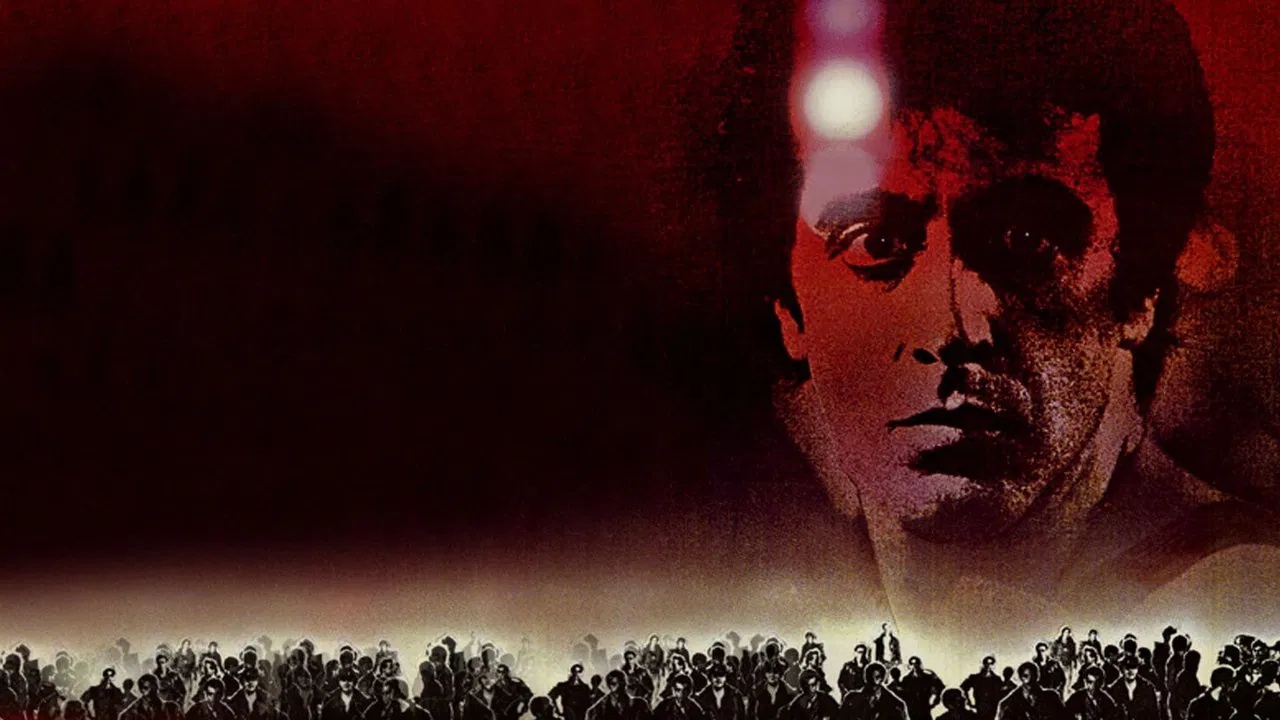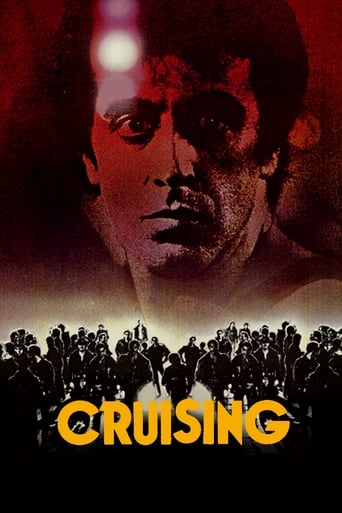

Sorry, this movie sucks
... View MoreA Major Disappointment
... View MoreAll of these films share one commonality, that being a kind of emotional center that humanizes a cast of monsters.
... View MoreStrong acting helps the film overcome an uncertain premise and create characters that hold our attention absolutely.
... View MoreHonestly, Cruising isn't that good of a film. That's it. I guess there's a reason that I never saw this particular Pacino film until yesterday. You can give this one a miss.
... View MoreWilliam Friedkin directed not only The French Connection and The Exorcist, he also directed The Boys In The Band then years before Cruising. If there is an evolution in how the straight world saw the gay world in the decade between Boys In The Band and Cruising, the evolution is backwards. The gay scene in Crusing is sheer hell and I have to believe that it reflected the Country's mood of the day. In not such subtle ways Cruising tells us about the depravity of one group threatening the other. If you think I'm wrong, why then the gay sex and enviroment is wrapped in violent rock music in which actual feelings are not even present but the heterosexual sex scenes between - the always wonderful Al Pacino and the beautiful Karen Allen are wrapped in lyrical classical music, all feeling, tenderness and light. As soon as the film ended I had to wash my face and pour myself a double scotch on the rocks. I was kind of angry and definitely disturbed. Oops, maybe I recommending Cruising without meaning to.
... View MoreThe controversy over this supposed anti-gay film has stirred debate for nearly 40 years. The slaying of gay men part of the leather and s&m scene is violent and ugly, a view of just one small portion of the community. I've seen it through various gay pride and marches, Folsom Street Fair, visits to Silver Lake near downtown Los Angeles, and various Halloween parades. It does exist, and this is part of its story in the gay naked city.While cop Al Pacino comes off a little brusk, he's just out to do his job, even if disguising himself as a gay man is repulsive to him. He's not homophobic, just not interested in that sort of thing. But in spite of his reluctance and longterm relationship with Karen Allen, he's gotta do what he's assigned to do. So it's off to the gay leather bars of midtown Manhattan and the woods of Central Park.The murders are brutal, showing the fear of the victim before they are killed. This lifestyle isn't just about the gays; perversion crosses over and this just uses a small portion of the gay community to tell its story. It's just not a very good movie. Don Scardino plays an effeminate gay man who befriends Pacino, and it's obvious that Pacino likes him in spite of their differing sexualities. As a gay man, I look back on it as a warning against promiscuity, and with the AIDS crisis just around the corner, it's a bit prophetic.
... View MoreAfter "The Exorcist" (1973) and "The French Connection" (1971), William Friedkin fell hard and fast into the world of mediocrity. Before his career crashed and burned, however, he made 3 fairly interesting films.Released in 1977, "Sorcerer" was Friedkin's remake of 1953's "Wages of Fear". Both films find a group of international criminals hiding from the law in a small South American village. Struggling to make ends meet they agree to work for an oil company. Their task? Drive truckloads of volatile nitroglycerin over three hundred miles of treacherous jungle terrain. Though tense in places, "Sorcerer" was a huge box office flop. A stupid title and poor marketing meant that audiences stayed well away. Like Coppola, Friedkin took his crew to the jungle and seemed to never quite return. Three years after "Sorcerer", Friedkin directed "Cruising", a little known film staring Al Pacino. Here Pacino plays an undercover police officer who poses as a homosexual man in the hopes of catching a serial killer responsible for murdering several gay men. As such, Pacino infiltrates the "leather bars", a subculture of gay life in which men wear S&M fetish-wear. "Cruising's" a fairly interesting film, but Friedkin's portrayal of gay lifestyles is too caricatural, too derogatory (homosexuals as lair dwelling vampires?), and his plot rarely excites. Worse still is the film's thin vein of homophobia, and Friedkin's aligning of gay sex to physical violence (earlier edits subliminally spliced shots of hard-core penetration into the film's murder sequences). This isn't as dubious as some of Friedkin's other works - the racist/crypto-Imperialist "Rules of Engagement", the death-penalty loving "Rampage", the ultra conservative, science/woman/hippie bashing "Exorcist" etc - but almost. Lifting the climax to 1977's "Looking for Mr Goodbar", Friedkin then ends with Pacino's character's latent homosexuality triggering a self-loathing that sees him assuming the place of the film's killer. This climax has been criticised by many, but is one of the film's saving graces. Here, law enforcement and bourgeois values are portrayed as being inherently repressive, violent and constructed via the destruction of everything that deviates from traditional masculinity. In other words: cops hate gays because they're repressing their own touchy-feely, homo-erotic feelings.Beyond this, "Cruising" boasts some fine cinematography, the director using the black and white motifs of the leather bars to sculpt the entire look of his film. Aside from some cold blues, "Cruising" might as well be monochromatic.Friedkin's last watchable film was "To Live And Die in LA", one of the better crime pictures of the 1980s (see the superior "Cutter's Way"). It stars William Petersen as a Secret Service agent responsible for tracking down a counterfeiter, but Friedkin's plot is unimportant. Savour instead the film's breezy atmosphere, catchy soundtrack and its slick action sequences. What's most interesting about "To Live And Die In LA", however, is its possible influence on director Michael Mann. Petersen would star in Mann's "Manhunter" several years later, a film in which Mann's style changes drastically from the dour tone he initially utilised in "Thief" (1981). Mann seems to have also been influenced by Friedkin's use of the German electronic group Tangerine Dream (who scored "Sorcerer" and who brought synthesisers and trance music to the mainstream) and the stylised visuals that Friedkin had hit upon. Of course Mann's "Miami Vice" was released a year before "To Live and Die", so it may well be Mann who's the influence on Friedkin.Regardless, in many ways "To Live and Die in LA" is the link between the gritty crime films of the 1970s and the more stylised crime films that would came later; the point at which neo-realism meets slick MTV visuals and cutting. In the 1990s, Michael Mann would marry this cocktail to the designer existentialism of Jean Pierre Melville (see "The Samurai", "The Fingermen", "Bob the Gamber"), giving rise to "Heat".5/10 - See "Cutter's Way".
... View More